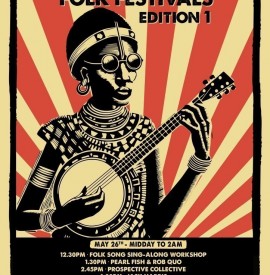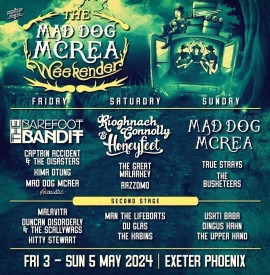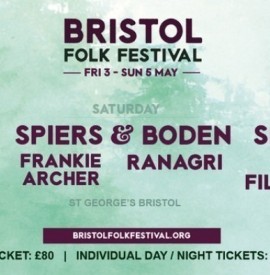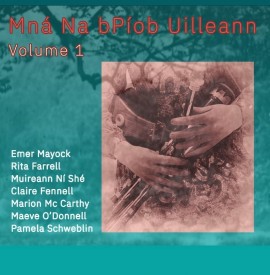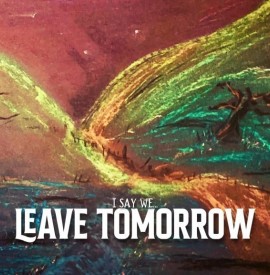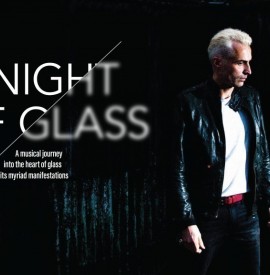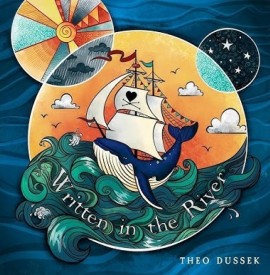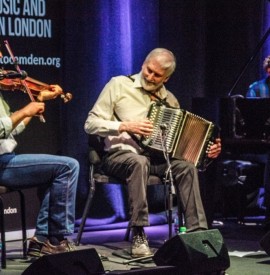London Folk Magazine and News
Celtic Connections - Review

Ursula May reviews the first week of Celtic Connections 2021 for Folk & Honey
A highland piper steps off a subway train, cruises up an escalator and strides out into the Merchant City on a grey day, blasting out a stately air. He’s joined by another, then a pair more, until eight pipers are traversing the grand steps of Glasgow’s Royal Concert Hall, bringing the melody in. They circle and play out their tune in the round. Celtic Connections 2021 has begun.
I attended the festival in January 2020, making the pilgrimage from Bristol to see the GRIT Orchestra’s rendition of the work of Martyn Bennett, orchestrated and conducted by violinist Greg Lawson of alt-klezmer class act Moishe’s Bagel. As we crossed the border, we pressed play on Bennett’s Move; the sun escaped the clouds and the landscape was illuminated, golden fields and majestic peaks sonically mirrored in the music - a profound connection between music and place. After a wild weekend, I spent the journey home dreaming of a return to the festival and land that had captured my imagination so forcefully and wouldn’t let go.
Now I’m back, albeit in an unexpected form. After a year starved of live music, a 19-day programme of top-quality online folk shows is balm for the soul. Here are a few highlights from the opening week.
The festival settles at home initially, rooting us in place and tradition. From the stunningly ornate City Chambers comes an intimate singaround of local stalwarts and troubadours. In Come Away In, folk icon Karine Polwart articulates the importance of offering refuge to those in need. Her warm words and delivery are an invitation to the outsider, a cordial welcome to us all.
From refugees to referendums: twinkling Findlay Napier on the difficulties of resurrecting ship-building in response to “all the nonsense chat” in 2016. Siobhan Miller’s sensitive songbird takes on The King’s Shilling – of men being tricked into taking up arms; and Pound a Week Rise – protesting mining’s poor conditions and wages – honour “the men who were fooled by the government’s lies.” Rab Noakes uses wry vignettes to cast a beady eye from past to present, comparing a local car wash to “an agricultural feeing-market from the past,” and muses: “Hard to look the world in the eye somedays, as I wonder if we’re ever going to fix our ways.” A potent start to proceedings.
I miss the fields; I hoped the festival might reconnect me with those long-lost hazy days and nights of revelry. Cue Shooglenifty, infamous originators of Acid Croft, fusing trad and electronica. Fiddler Angus – agile bowman, inspired tune-making maverick - is sorely missed after passing away in 2016. It’s no surprise that he’s responsible for the set’s most hypnotic tune. Hunting for Angus is a powerful tribute, to the man’s magical ability to vanish to evade duty, and to “all the houses, trees and laughs and love; all the skies that you saw were all your own; all the friends where you made yourself a home.” This melancholic acid Scots trance-dance seems a most fitting way to pay respects.
It’s a compact set-up that brings the biggest thrill of the festival so far, by a seriously merry mile. Talisk are a full-throttle power trio. In a breathless introduction Mohsen Amini - an excitable Danny Zuko-esque character in black leather jacket and skinny jeans – exclaims “we want to see you up, dancing, shouting for joy!” They set off at full pelt, lightspeed violin joined by quicksilver concertina: fiddler Hayley Keenan woops with excitement. I’m on the edge of my seat. They up the unfeasible speed, adding a wash of vocals, Amini punching the bass with his foot whilst deftly mastering impossible melodies. They’re a whirling force of interlocking rhythms and tune. Amini almost throws himself off his chair. I’m left gasping.
This folk energy explosion must be seen to be believed. Though it may necessitate a new set of eyeballs.
The Scots Gaelic performances are notable too. At last count, only 1.1% of the population are fluent in the indigenous language which is on UNESCO’s ‘definitely endangered’ list. In its prominent representation, the festival hints at a buried potential. Mining the rich seams of Celtic languages, music and stories would give a greater connection to history, ancestry, landscape – the heart and soul of people and place.
Kathleen MacInnes’ voice is rich and earthy, of malt and peat. Piano and pithy violin accompaniment is sparse but runs deep. Deirde Graham takes a more contemporary approach. Her voice is rawer, emphasising the punctuating staccato sounds of the tradition. The melodies’ lyrical, cyclical nature is entrancing.
From the heart of tradition to the innovators of Celtic sound and form: the week saw some shining examples of new ways with folk.
Chris Stout and Catriona McKay combine experimental fiddle and harp with atmospheric visuals. The string sounds are stark, ghostly, broad and belting. The pair run the gamut of their instruments in this epic soundscape, from gritty rhythms to rippling runs, rhapsodic melodies to metallic strums. They fade in and out of landscapes; nature scenes provide textural impressions, instilling the call of the wild: silver birch appears above moving water, reflecting biting violin-hewn chords and harp ripples. The mesmerising audio-visual dimension is made possible only by the online format.
Aidan O’Rourke builds landscapes with music and motion. In 365 the fiddler, of post-folk outfit Lau, wrote a tune every day for a year in response to James Robertson’s collection of short stories of the same undertaking. The free-flowing soundscapes are accompanied by readings from Robertson’s book. Aidan’s signature fluid style is compelling: he rolls and sways as if violin and music are an extension of his self. The music flows like waves shifting sands. It starts as an extension of the story but quickly moves to tell its own tale, albeit a slippery one that’s tricky to grip.
Rachel Newton draws on ancient poems and songs but her lockdown album To the Awe, focusing on women’s perspective and narrative, is contemporary and inventive. With doomy keys and booming sousaphone – along with trombone and flugelhorn, the festival’s only brass so far – this isn’t just another reverent folk revival. While Rachel’s clear delivery speaks to the traditional her vision is anything but.
The album concept is intriguing too. A poem by Lady Nairn, a contemporary of Burns, is an inspired choice. This fragment of an alternative past shines a spotlight on historical bias and assumptions. It reminds us to look for what’s missing, to seek out the ignored and forgotten figures, stories and inspirations.
The festival goes global with a pick and mix of Scotland’s diverse communities and live shows beamed in from Europe, Africa and India.
The Ando Glaso collective features traditional music from the Bihor region of Romania with three fiddles, accordion and keys. The men are motionless as they pick out heart-wrenching melodies and furiously intricate solos of utter vitality. Danish Dreamers’ Circus also perform with quiet intensity, weaving complex webs of ‘New Nordic folk’ with gossamer light-touch strings and keys. The World Was Waiting features the trio whistling a sweet four-bar refrain that captures the uncertainty, longing and hope that defines this unique moment in time.
Watching the Cosmic Shruti Box, I can only imagine the spine-tingling crackle and collective breath-holding in the room. Tibetan singing bowls, sitar, endongo and tabla combine to electrifying effect. The musicians play with reverence for the notes, the spaces in between and the collective whole. The Shruti, a shared love for musical sound, is in evidence here.
From Santiago de Compostela, Xabier Diaz & Adufeiras de Salitre perform from his collection of Galician village songs. Its ingenious title, Mr Tambourine Man, refers to Xabier’s renowned abilities with the Pandeireta Galega, or Galician tambourine; his accompanists play the adufe, a square frame drum of Moorish origin. Xabier intones and eleven drums beat in unison, augmented by haunting hurdy gurdy and accordion. It’s a snapshot of the past brought to life by this master of folklore, serious in the highest possible execution of his craft.
Finally, the pinnacle of the week: The Womanly Voices of Jodhpur, singing exuberantly to the dawn that breaks behind them to reveal the vast, golden Mehrangarh Fort. It’s devotional in essence, with powerful cascading voices accompanied by clinking khartal and wailing Indian strings. These are amongst the first Rajasthani women to perform with such prominence as, historically, women were not encouraged to pursue the folk arts publicly. The Rajasthan International Folk Festival (RIFF) is working to make change here. Jodphur’s Maharaja asserts “Folk music might not survive, because (musicians) are going to other professions; it’s important they’re given a sense of pride and remain authentic. That’s why this festival is highly important.”
In a way, he speaks for Celtic Connections, and for music at large in this challenging time. It’s a reminder to stick to our guns. Before we know it, we’ll be back in the room once again; for now, the virtual experience is a satisfying stand-in. I can’t wait to take a leap into next week to see what new surprises the festival has in store. If you’re quick, you can catch some of it too.
Ursula May on Instagram: @ursulambb
Email: maybessiebill@gmail.com









